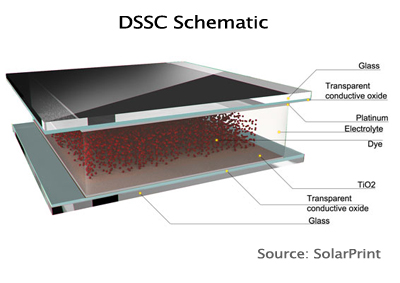Es handelt sich um eine Anwendung aus der Bionik, die ihrer Funktion nach auch elektrochemische Farbstoff-Solarzelle genannt wird. It is based on a semiconductor formed between a photo- sensitized anode and an electrolyte, a photoelectrochemical system. The modern version of a dye solar cell, also known as the Grätzel cell, was originally co- invented in . The dye-sensitized solar cells (DSC) provides a technically and economically credible alternative concept to present day p–n junction photovoltaic devices. In contrast to the conventional systems where the semiconductor assume both the task of light absorption and charge carrier transport the two functions are separated .

Energy crisis is what being faced by every country today. Many efforts have been devoted to overcome the problems. One of several offered solutions is to develop solar cells (SCs) since solar energy is abundant and free to use.
Especially in a tropical country like Indonesia, solar energy is available a whole year with quite . The aim of this brief review is to give a short and simple overview of the dye- sensitized solar cell technology from the working principles to the first commercial applications. It emphasizes the role of the sensitizer and the strategies to improve the performances of the dye as well as some recent development aiming to answer . In the last two decades, dye-sensitized solar cells (DSSCs) have attracted more attention as an efficient alternative to economical photovoltaic devices, and the highest efficiency record has increased from ∼ to ∼. To be more competitive in the solar cell markets, various organic materials are investigated and used .

Dye Sensitized Solar Cells (DSSC) are thin film solar cells based on the photo electrochemical processes. Dye-sensitized solar cells (DSSC) are an efficient type of thin-film photovoltaic cell. They are based on printable semiconductor materials, including an electrolyte and a photo-sensitized anode.
Dye sensitized solar cell (DSSC) is the only solar cell that can offer both the flexibility and transparency. Its efficiency is comparable to amorphous silicon solar cells but with a much lower cost. This review not only covers the fundamentals of DSSC but also the related cutting-edge research and its . The DSSC is a liquid-type device that involves nanoporous titanium oxide (TiO2) as a semiconducting electrode, organic dye-sensitizer and electrolyte solution containing a redox component.
My research team has been experimenting with DSSCs: dye-sensitized solar cells. They differ from traditional photovoltaic (PV) cells that currently dominate the solar cell market, and DSSCs have their own advantages and disadvantages. The tradeoffs will be discussed later in this guide. Please do not re-upload this video on your Channel. If we find we will remove it, your channel will get copyright.
How does a Die Sensitized Solar Cell work? Solar cells that operate efficiently under indoor lighting are of great practical interest as they can serve as electric power sources for portable electronics and devices for wireless sensor networks or the Internet of Things. Here, we demonstrate a dye-sensitized solar cell (DSC) that achieves very high . Here, we report a molecularly engineered porphyrin dye, coded SM31 which features the prototypical . Paying homage to its inventor Professor Michael Gräetzel we call it GCell.

Over the last decade, dye-sensitized solar cells (DSSCs) have attracted much attention because these unconventional solar cells exhibit high performance and have the potential for low-cost production. Recently, solar energy-to-electricity conversion efficiencies as high as under AM 1. G irradiation have been .